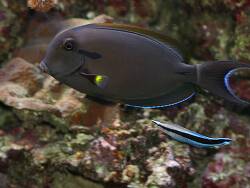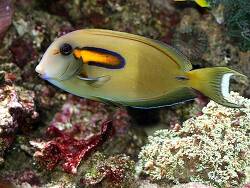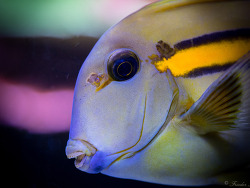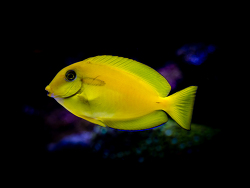Info
Bloch & Schneider, 1801
The Orangespot Surgeonfish, also known as Orange-epaulette or Orange shoulder Surgeonfish, is one of easier surgeonfish species to care for in captivity. Juveniles show a solid yellow with only the slighest hint of blue fringing on the anal and dorsal fins. When it matures, the front half of the body turns light grey and the back half takes on a dark grey-blue color. Most striking is the eye-catching orange stripe above the pectoral fins. Adults also have a lyre-shaped caudal fin.
As a rule the Orangespot Surgeonfish is a reef-safe and peaceful community fish which may even be kept together with other tangs. It requires a tank setup with plenty of hiding places as well as plenty of swimming space for its well-being.
It grows rather fast and will reach a length of 14 inches (35 cm).
Feeding requirements see other Acanthurus species.
Synonyms:
Acanthurus chrysosoma Bleeker, 1857
Acanthurus eparei Lesson, 1830
Acanthurus humeralis Valenciennes, 1835
Ctenodon erythromelas Swainson, 1839
Harpurus paroticus Forster, 1844
Hepatus chrysosoma (Bleeker, 1857)
Hepatus olivaceus (Bloch & Schneider, 1801)
Rhombotides olivaceus (Bloch & Schneider, 1801)
Rhombotides xanthosoma Bleeker, 1865
Teuthis olivaceus (Bloch & Schneider, 1801)
Classification: Biota > Animalia (Kingdom) > Chordata (Phylum) > Vertebrata (Subphylum) > Gnathostomata (Superclass) > Pisces (Superclass) > Actinopterygii (Class) > Perciformes (Order) > Acanthuridae (Family) > Acanthurinae (Subfamily) > Acanthurus (Genus)
The surgeonfishes (Acanthuridae), popular in marine aquaristics, are also called surgeonfishes.
They have horn-like blades in front of the tail root, they use as mainly defensive weapon (defense) against predators, but this sharp weapon is also used in fights among themselves.
Deep cuts in the body of opponents can cause permanent injuries, but often death occurs immediately.
If surgeonfishes are to be kept in pairs in an aquarium, fights between the fishes can be the order of the day, we could observe this several times with the very popular Hawaiian surgeonfish (Zebrasoma flavescens).
The scalpel-like blades can cause deep cuts, this is also true for the careless aquarist who wants to touch or catch the fish with unprotected hands.
Another problem can occur if one wants to catch surgeonfish with a landing net and transfer them after catching, the horn blade can easily get caught in the net.
Caution: Careless handling of the animal can cause deep cuts!
The Orangespot Surgeonfish, also known as Orange-epaulette or Orange shoulder Surgeonfish, is one of easier surgeonfish species to care for in captivity. Juveniles show a solid yellow with only the slighest hint of blue fringing on the anal and dorsal fins. When it matures, the front half of the body turns light grey and the back half takes on a dark grey-blue color. Most striking is the eye-catching orange stripe above the pectoral fins. Adults also have a lyre-shaped caudal fin.
As a rule the Orangespot Surgeonfish is a reef-safe and peaceful community fish which may even be kept together with other tangs. It requires a tank setup with plenty of hiding places as well as plenty of swimming space for its well-being.
It grows rather fast and will reach a length of 14 inches (35 cm).
Feeding requirements see other Acanthurus species.
Synonyms:
Acanthurus chrysosoma Bleeker, 1857
Acanthurus eparei Lesson, 1830
Acanthurus humeralis Valenciennes, 1835
Ctenodon erythromelas Swainson, 1839
Harpurus paroticus Forster, 1844
Hepatus chrysosoma (Bleeker, 1857)
Hepatus olivaceus (Bloch & Schneider, 1801)
Rhombotides olivaceus (Bloch & Schneider, 1801)
Rhombotides xanthosoma Bleeker, 1865
Teuthis olivaceus (Bloch & Schneider, 1801)
Classification: Biota > Animalia (Kingdom) > Chordata (Phylum) > Vertebrata (Subphylum) > Gnathostomata (Superclass) > Pisces (Superclass) > Actinopterygii (Class) > Perciformes (Order) > Acanthuridae (Family) > Acanthurinae (Subfamily) > Acanthurus (Genus)
The surgeonfishes (Acanthuridae), popular in marine aquaristics, are also called surgeonfishes.
They have horn-like blades in front of the tail root, they use as mainly defensive weapon (defense) against predators, but this sharp weapon is also used in fights among themselves.
Deep cuts in the body of opponents can cause permanent injuries, but often death occurs immediately.
If surgeonfishes are to be kept in pairs in an aquarium, fights between the fishes can be the order of the day, we could observe this several times with the very popular Hawaiian surgeonfish (Zebrasoma flavescens).
The scalpel-like blades can cause deep cuts, this is also true for the careless aquarist who wants to touch or catch the fish with unprotected hands.
Another problem can occur if one wants to catch surgeonfish with a landing net and transfer them after catching, the horn blade can easily get caught in the net.
Caution: Careless handling of the animal can cause deep cuts!







 Johnny Jensen, Dänemark
Johnny Jensen, Dänemark

































































